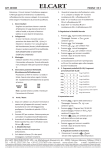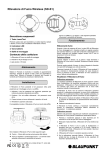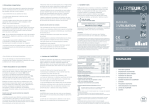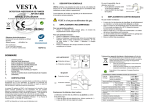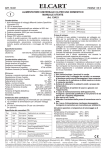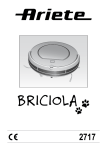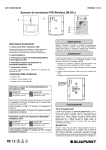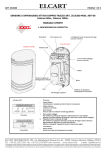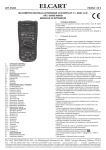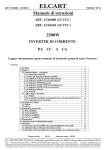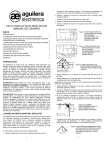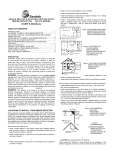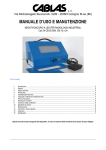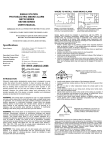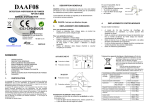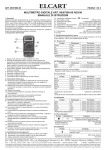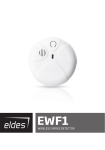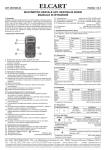Download ELCART
Transcript
ART. 35/08410-00 ELCART PAGINA 1 DI 8 Manuale di istruzioni/Scheda tecnica Alcune informazioni utili: • Installare Rilevatore di fumo fotoelettrico Manuale d’istruzioni Ideale per l’installazione in qualsiasi area un rilevatore di fumo nel corridoio all’esterno di ogni camera da letto separata, come indicato nella Figura 1. In abitazioni con due camere da letto, saranno necessari due rilevatori come indicato nella Figura 2. • Nel caso di abitazioni a più piani, installare un rilevatore di fumo per piano come mostrato nella Figura 3. • Installare un minimo di due rilevatori in ogni abitazione. • Installare un rilevatore di fumo all’interno di ogni camera da letto. • Installare rilevatori di fumo alla fine del corridoio che porta alle camere da letto se risulta più lungo di 12 mt. • Installare il rilevatore di fumo all’interno della camera da letto specialmente se si ha l’abitudine di dormire con la porta chiusa, già che il fumo può rimanere bloccato dalla porta chiusa e l’allarme posizionato all’entrata potrebbe non svegliarlo con la porta chiusa. SALA DA PRANZO CUCINA CAMERA DA LETTO CAMERA DA LETTO ART. 35/08410-00 SMK-500 (Wireless) SMK-500D (Indipendente) Introduzione Il nostro rilevatore di fumo fotoelettrico è progettato per rilevare la presenza di fumo in un determinato ambiente. Non rileva gas, il calore o fiamme. Questo rivelatore è stato progettato per segnalare anticipatamente lo sviluppo di fiamme attraverso la segnalazione acustica integrata nell’apparecchio. ATTENZIONE: Questo rilevatore di fumo è progettato per il solo utilizzo in una unità residenziale singola, ovvero deve essere utilizzato all’interno di un’abitazione singola o di un’appartamento. Non è destinato per un utilizzo in atri, corridoi, seminterrati, in appartamenti in condomini, salvo se sono già installati in modo indipendente altri rilevatori di fumo in ogni nucleo familiare esistente. I rilevatori di fumo installati in locali ad uso comune esterni all’unità familiare, come verande o corridoi, potrebbero non avvertire a tempo i residenti dell’edificio. Nei edifici residenziali multifamiliari, ogni appartamento individuale deve essere equipaggiato di rilevatori di fumo indipendenti. ATTENZIONE: Questo rilevatore di fumo non è progettato per un utilizzo in zone non residenziali, capannoni, edifici industriali o commerciali. I luoghi a fini non residenziali devono avere rilevatori di fuoco specializzati e sistemi di allarme. Questo rilevatore da solo non risulta adatto alla completa sostituzione di un sistema antincendio in locazioni dove lavorano molte persone come alberghi o motels, dormitori, ospedali, case di cura e cosi via, anche se sono edifici singoli. Si prega di riferirsi ai codici NFPA 101, NFPA71, 72A,72B,72C, 72D e 72E per le esigenze sui sensori di fumo per la protezione antiincendio in stabilimenti non definiti come “abitazioni”. Ubicazioni per l’installazione del rilevatore di fumo I rilevatori di fumo devono essere installati in accordo con lo standard NFPA 72 (Associazione nazionale protezione antiincendio). Per una completa copertura in ambienti residenziali, i rilevatori di fumo dovrebbero essere installati in tutte le stanze, corridoi, magazzini e attici. La copertura minima è costituita da un rivelatore per ogni piano e uno in ogni area da notte. SOGGIORNO CAMERA DA LETTO Installazione a bassa sicurezza Installazione ad elevata sicurezza Figura 1: Dove posizionare rivelatori di fumo nel caso di residenze con un’unica area da notte. CUCINA SALOTTO CAMERA DA LETTO CAMERA DA LETTO SOGGIORNO CAMERA DA LETTO Installazione a bassa sicurezza Installazione ad elevata sicurezza CAMERA DA LETTO Figura 2: Dove posizionare rivelatori di fumo nel caso di residenze con più di un’area da notte. CAMERA DA LETTO CAMERA DA LETTO PIANO TERRA CAMERA DA LETTO CUCINA GARAGE SEMINTERRATO Installazione a bassa sicurezza Figure 3: Posizionamento di rivelatori di fumo in residenze a più piani • Installare i rilevatori di fumo in un semiinterrato in fondo alla tromba delle scale. • Installare i rilevatori di fumo al secondo piano in cima alla tromba delle scale tra il primo ed il secondo piano. • Assicurarsi che nessuna porta o altri ostacoli blocchino il percorso del fumo verso il rilevatore. • Installare rilevatori di fumo addizionali in sala da pranzo, salotto, attico, camere di stoccaggio e ripostiglio. • Installare i rilevatori di fumo il più vicino possibile al centro del soffitto. Se non è possibile, installare il rilevatore sul soffitto, assicurandosi che non sia più lontano di 10 cm da ogni muro o angolo, come indicato nella figura 4. • Se l’installazione sul soffitto non è possibile, installare il rilevatore di fumo sul muro a 10÷15 cm dal soffitto, come indicato nella figura 4. • Se alcune stanze presentano un soffitto inclinato o non piano, installare il rilevatore di fumo a 90 cm dal punto più alto del soffitto, come indicato nella figura 5. ELCART DISTRIBUTION SPA via Michelangelo Buonarroti, 46 - 20093 Cologno Monzese (Milano) ITALY Tel. +39 02.25117310 Fax +39 02.25117610 sito internet: www.elcart.com e-mail: [email protected] La divulgazione dei dati contenuti in questa scheda è da ritenersi un servizio puramente informativo e non costituisce alcun vincolo da parte della Elcart in merito a prestazioni ed utilizzo del prodotto. The divulgation of data contained on this technical sheet are exclusively for informational reasons and establish no link on behalf of Elcart regard to thr performances and the usa of the product. La divulgacion de los datos contenidos en esta ficha son un servicio unicamente informativo y no constituyen ningun vinculo de parte de Elcart respecto a las prestaciones y uso del producto. ELCART ART. 35/08410-00 PAGINA 2 DI 8 Manuale di istruzioni/Scheda tecnica SOFFITTO CENTRO DEL SOFFITTO 4 inch (10cm) MAI QUI 4 inch (10cm) Minimo 6 inch (15cm) Max IMPORTANTE: Per qualsiasi motivo, non disabilitare l’unità per evitare allarmi indesiderati. In condotte di areazione della cucina. Il modo in cui un rilevatore di fumo rivela le particelle di combustione in normali percorsi di corrente d’aria è mostrato nella figura 6, indicando i luoghi corretti e non corretti dove posizionare il rilevatore. MIGLIOR POSIZIONE POSIZIONE ACCETTABILE Figura 4: Posizioni raccomandate per installare il rilevatore CORRENTE D’ARIA ENTRATA ARIA CAMERA BAGNO DA LETTO FORNELLI CUCINA RILEVATORE CAMERA DA LETTO 9 FEET (2,75 mt.) DISTANZA ORIZZONTALE DAL VERTICE SOGGIORNO UBICAZIONE CORRETTA UBICAZIONE ERRATA Figura 5: Modalità d’installazione con soffitto inclinato Figura 6: Posizioni raccomandate dove installare il rilevatore per evitare correnti di aria con particelle di combustione ATTENZIONE: “Un allarme precoce del rilevamento del fuoco si ottiene grazie all’installazione di un sistema di rilevamento di fuoco in ogni camera da letto e le varie zone della casa come segue: (1) Un rilevatore di fuoco installato in ogni camera da letto separata (vicino, ma fuori dalla stanza), e (2) un rilevatore installato nel salone, sala da pranzo, cucina, corridoi, solai, gabinetti, ripostiglio e zone di stoccaggio, ed i garage annessi”. Per informazione, conforme allo standard NFPA 74, Sezione 2-4, afferma: “2-4.1.1 I rivelatori di fumo e calore devono essere installati al di fuori di ogni zona notte, nelle immediate vicinanze delle camere da letto e in ogni area supplementare compresi scantinati.” Le disposizioni del 2-4.1.1 rappresentano il numero minimo di rilevatori richiesti dalla presente norma. Si raccomanda che il padrone di casa prenda in considerazione l’uso di rivelatori aggiuntivi per una maggiore protezione per le aree separate da una porta dalle aree protette dal rivelatore. Le ulteriori aree consigliate sono soggiorno, sala da pranzo, camera da letto (s), cucina, mansarda, ripostiglio, cantina, garage integrato o collegato, e corridoi non inclusi nel 2-4.1.1 sopra. Tuttavia, l’uso di rilevatori aggiuntivi non è obbligatorio ed è una decisione del capo famiglia. “Raccomandiamo una copertura completa e l’uso di rivelatori di fumo e calore supplementari.” • In presenza di bagnato o aree molto umide o vicino a bagni con doccia. La condensa può entrare nella camera di rilevamento, quindi creare gocce di raffreddamento capaci di causare falsi allarmi. Installare il rilevatore al meno a 3 metri da bagni. • In zone molto fredde o molto calde, inclusi edifici non riscaldati o stanze esterne. Se la temperatura è maggiore o minore dell’intervallo di rilevamento del rilevatore di fumo, questo non funziona. Rispettare l’intervallo di rilevamento da 4°C÷38°C (40°F÷100°F). • In prossimità di condotti di ventilazione o zone con correnti d’aria come condizionatori, radiatori o ventilatori. Questi condotti di ventilazione e correnti d’aria potrebbero allontanare il fumo dai rivelatori. • In zone di aria morta. Sono spesso localizzate a livello del tetto o negli angoli formati dal soffitto con il muro. L’aria stagnata potrebbe impedire al fumo di arrivare al rilevatore. Riferirsi alle figure 4 e 5 per una corretta scelta del luogo di installazione. • In zone infestate da insetti. Può accadere che questi insetti entrino nella camera di rilevazione causando allarmi indesiderati. Quando gli insetti possono essere un problema, disinfestare l’area prima di installare i rivelatori. • In prossimità di luci fluorescenti. Il rumore elettrico delle luci fluorescenti può causare falsi allarmi. Installare i rivelatori di fumo ad almeno 1,5 metri da queste luci. Dove non installare i rilevatori di fumo I falsi allarmi possono avvenire se i rivelatori vengono installati dove non funzionerebbero correttamente. Per evitare i falsi allarmi, non installare i rivelatori di fumo e di calore nelle seguenti situazioni: • In prossimità di zone dove sono presenti particelle di combustione, tali come cucine con poche finestre o poca ventilazione, garages dove si possono trovare fumi di scarico provenienti da veicoli, riscaldamento ad acqua calda, riscaldatori. • Non installare i rilevatori di fumo a meno di 6 metri da luoghi dove le particelle di combustione sono presenti (come cucine). Se una possibile distanza non è ottenibile, provare ad installare il rivelatore il più lontano possibile dalle particelle di combustione, preferibilmente sul muro. Provvedere ad una adeguata ventilazione. ATTENZIONE: Non togliere mai la batteria del rilevatore per fare cessare allarmi indesiderati. Aprireuna finestra o attivare un ventilatore per fare partire via il fumo. Il rilevatore si disattiverà da solo. Se l’allarme persiste, pulire il rilevatore come descritto in questo manuale di istruzioni. ATTENZIONE: Evitare di rimanere troppo a lungo vicino al rilevatore quando è in allarme. Il rumore è potente, l’eccessiva esposizione potrebbe danneggiare l’udito. ELCART DISTRIBUTION SPA via Michelangelo Buonarroti, 46 - 20093 Cologno Monzese (Milano) ITALY Tel. +39 02.25117310 Fax +39 02.25117610 sito internet: www.elcart.com e-mail: [email protected] La divulgazione dei dati contenuti in questa scheda è da ritenersi un servizio puramente informativo e non costituisce alcun vincolo da parte della Elcart in merito a prestazioni ed utilizzo del prodotto. The divulgation of data contained on this technical sheet are exclusively for informational reasons and establish no link on behalf of Elcart regard to thr performances and the usa of the product. La divulgacion de los datos contenidos en esta ficha son un servicio unicamente informativo y no constituyen ningun vinculo de parte de Elcart respecto a las prestaciones y uso del producto. ELCART ART. 35/08410-00 PAGINA 3 DI 8 Manuale di istruzioni/Scheda tecnica Installazione del rilevatore di fumo Il rilevatore di fumo è stato progettato per essere installato sul soffitto o sul muro se necessario. Riferirsi prima ai due paragrafi precedenti per decidere dove e come installarlo. Seguire i passi seguenti per installare il rilevatore di fumo: 1.Scegliere il luogo di installazione e tracciare una linea orizzontale lunga 15 cm. 2.Rimuovere la staffa dall’unità ruotandola in senso antiorario. 3.Fissare la piastra di base nella posizione di montaggio desiderata e contrassegnare i due fori con una penna. 4.Rimuovere la staffa. 5.Praticare due fori con una punta da trapano di 5 mm ed inserire due stopper nei fori. Tenere il rilevatore di fumo lontano da eventuale polvere causata dal trapano. 6.Fissare la piastra inferiore con le viti e tasselli corrispondenti. 7.Allineare il rilevatore alla staffa, premerlo contro e ruotarlo in senso orario per bloccarlo. Assicurarsi che l’installazione sia stabile. STAFFA DI FISSAGGIO RILEVATORE VITI NOTE: Quando la batteria è stata inserita, il rilevatore emetterà un beep sonoro per confermare che la batteria è stata inserita correttamente. Chiudere il coperchio e premere il tasto di test per 5 secondi fino a che non viene emesso un suono. Ciò significa che l’apparecchio funziona correttamente. ALTOPARLANTE LED ROSSO PULSANTE DI TEST Abbinamento del rilevatore con un pannello di controllo Il rilevatore di fumo 35/08410-00 può essere utilizzato individualmente o abbinato ad un pannello di controllo per integrare un sistema di allarme via modulo wireless del rilevatore. 1.Assicurarsi che il pannello di controllo sia in modalità learning (abbinamento). 2.Premere il tasto test del rilevatore per 3 secondi, due beep sonori confermeranno l’abbinamento. Il pannello di controllo emetterà anche lui un beep per indicare che l’operazione è stata effettuata con successo. Fase test: Premere il tasto test per 3 secondi, il pannello di controllo si metterà in allarme automaticamente. Indicatore LED Rosso VITI Per aprire il coperchio della batteria ed installarla, procedere nel modo seguente: 1.Per azionare il rilevatore di fumo si richiede una batteria. 2.Aprire il compartimento batteria ed installare la batteria all’interno, assicurarsi che “+” e “-” siano allineati contemporaneamente. 3.Chiudere il vano batteria fermamente fino allo scatto in posizione. Il rilevatore di fumo è equipaggiato di un indicatore LED rosso situato presso il tasto Test. Quando l’indicatore LED rosso lampeggia una volta ogni 32 secondi, significa che il rilevatore è in condizione di funzionamento normale. Quando il LED rosso è acceso in modo continuo e simultaneamente il cicaclino interno del rilevatore emette un beep acustico, questo indica che il rilevatore sta rilevando una condizione di allarme. Test del rilevatore di fumo Per assicurarsi che il rilevatore di fumo stia funzionamento correttamente testare settimanalmente il sensore premendo il tasto Test fino all’emissione del beep di conferma. Per ottenere il beep sonoro ci vogliono circa 5 secondi. Questo è l’unico modo per verificare se il rilevatore funziona correttamente. Se il rilevatore non emette nessun suono acustico, significa che deve essere immediatamente riparato o sostituito. BATTERIA ATTENZIONE: Il rilevatore è dotato di un meccanismo sul coperchio in modo da evitare che si chiuda qualora la batteria non sia installata correttamente. Il rilevatore non funzionerà fino a quando la batteria non sarà posizionata correttamente. ATTENZIONE: Evitare assolutamente di utilizzare una fiamma per testare il rilevatore: è possibile danneggiare il prodotto e la sua abitazione. Utilizzare unicamente il tasto test. ATTENZIONE: Quando non si sta testando il rilevatore e l’apparecchio emette un suono, significa che sono state rilevate delle particelle di fumo. Assicurarsi della gravità della situazione rilevata. L’allarme può essere causato da fumo proveniente dalla cucina. Se succede, aprire una finestra e fare circolare l’aria in maniera da rimuovere il fumo. Il rilevatore di fumo smetterà di suonare appena l’aria sarà pulita. NOTA: Non disconnettere l’alimentazione o estrarre la batteria dal rilevatore. La sua abitazione non sarà più protetta dal fuoco. ELCART DISTRIBUTION SPA via Michelangelo Buonarroti, 46 - 20093 Cologno Monzese (Milano) ITALY Tel. +39 02.25117310 Fax +39 02.25117610 sito internet: www.elcart.com e-mail: [email protected] La divulgazione dei dati contenuti in questa scheda è da ritenersi un servizio puramente informativo e non costituisce alcun vincolo da parte della Elcart in merito a prestazioni ed utilizzo del prodotto. The divulgation of data contained on this technical sheet are exclusively for informational reasons and establish no link on behalf of Elcart regard to thr performances and the usa of the product. La divulgacion de los datos contenidos en esta ficha son un servicio unicamente informativo y no constituyen ningun vinculo de parte de Elcart respecto a las prestaciones y uso del producto. ART. 35/08410-00 ELCART Manuale di istruzioni/Scheda tecnica Funzione di tacitazione dell’allarme La funzione di tacitazione permette di silenziare la segnalazione acustica a seguito di un allarme per un periodo di tempo di 8 minuti. Per attivare questa funzione, premere il tasto Test. Durante il periodo di tacitazione, la spia Led lampeggerà ogni 8 secondi (durante 8 minuti) per ricordare che la funzione è attivata. Passato il tempo di 8 minuti, la spia Led smetterà di lampeggiare per segnalare che il rilevatore è di nuovo in modalità di funzionamento normale. ATTENZIONE: La funzione di tacitazione non disattiva il funzionamento del rilevatore. È solo temporaneamente meno sensibile al fumo. Per ragioni di sicurezza, se l’apparecchio rileva del fumo abbastanza denso da raggiungere la soglia di allarme, si attiverà l’allarme. Se non si conosce l’origine del fumo, verificare la situazione prima di pensare ad un falso allarme. I sistemi di rilevazione fumo sono un’importante aiuto per ridurre danni, infortuni e rischi di morte. NOTA: Non scollegare l’alimentazione o estrarre la batteria dal rilevatore. La sua abitazione non sarà più protetta dal fuoco. Questo rilevatore è dotato di una spia “batteria scarica” e di un avvisatore acustico. Emette simultaneamente segnalazioni acustiche ad intervalli di 1 minuto e ha una durata residua di almeno 30 giorni prima che le batterie si scarichino completamente. Quando si sente questo segnale di avvertimento, sostituire le batterie. Se invece il rilevatore emette suoni acustici intermittenti e la spia Led si accende ad intervalli di un minuto, significa che deve essere immediatamente riparato o sostituito. Manutenzione del rilevatore di fumo Per mantenere il rivelatore in buone condizioni di funzionamento effettuare un test di funzionamento con cadenza settimanale. Consultare la sezione “Test del rilevatore di fumo”. Sostituire la batteria del rilevatore appena emette il segnale di batteria scarica ogni minuto. PAGINA 4 DI 8 Specifiche tecniche Alimentazione: 1 Batteria 6F22 9VCC Consumo allarme disattivo: ≤5µA Consumo allarme attivo: ≤15mA Frequenza segnale LED in modalità normale: Once every 32 sec. Frequenza segnale LED in modalità allarme: Once every 0.62 sec. Segnalazione Batteria Scarica: Un beep sonoro una volta ogni minuto Condizioni Operative: Temperatura: -10°C÷+55°C Umidità relativa: ≤95% (senza condensa) Area di copertura: 20m2 Livello di suono allarme: 85dB/3mt. Frequenza di trasmissione: 315MHz, 433.92MHz or 868MHz Distanza di trasmissione: ≤80mt. in spazio aperto (SMK-500) Materiale: Plastica ABS Dimensioni (LxWxH): 102x102x31 mm NOTA: Utilizzare solo batterie di tipo Gold Peak 1604P, 1604S, 1604G, 1604A; Eveready 522, 216; Duracell Mn1604; Premisafe G6F22; Ultralife U9VL-J; EVE CR9V. ATTENZIONE: Non utilizzare altri tipi di batterie. Il rilevatore potrebbe non funzionare correttamente. Aprire il coperchio ed aspirare la polvere/particelle presenti nella camera di rilevazione almeno una volta al’ anno. Si può effettuare la pulizia ogni volta che si sostituisce la batteria. Prima di pulire il rilevatore, estrarre la batteria. Utilizzare un aspirapolvere a spazzola, soprattutto in corrispondenza della aperture della camera di rilevazione. Terminata la pulizia, rimettere la batteria e testare il rilevatore per verificarne il corretto funzionamento. Mai utilizzare agenti liquidi per pulire. Verificare che non rimanga polvere sul tasto Test. Rimuovere la polvere con uno stuzzicadenti con cautela. NOTA: Se il rilevatore rileva frequentemente falsi allarmi, si deve controllare se la posizione di installazione del rilevatore è appropriata. Riferirsi alla sezione “UBICAZIONI PER L’INSTALLAZIONE DEL RILEVATORE DI FUMO”. Spostare il rilevatore se non è stato posizionato correttamente. Pulire il rilevatore come indicato in precedenza. Non immergere il prodotto in acqua. Non utilizzare detergenti abrasivi o a base di sostanze chimiche. Sostituire la batteria e rimettere il coperchio adeguatamente. Effettuare un test per verificare il corretto funzionamento del rilevatore. Informazione agli utenti ex art. 26 D.Lgs. 49/2014 Il simbolo riportato sull’apparecchiatura (Allegato IX D.Lgs. 49/2014) indica che il rifiuto deve essere oggetto di “raccolta separata” e che è stato immesso sul mercato, in Italia, dopo il 31/12/2010. Pertanto, l’utente dovrà conferire (o far conferire) il rifiuto ai centri di raccolta differenziata predisposti dalle amministrazioni locali, oppure consegnarlo al rivenditore contro acquisto di una nuova apparecchiatura di tipo equivalente. L’utente ha dunque un ruolo attivo: la raccolta differenziata del rifiuto e le successive operazioni di trattamento, recupero e smaltimento favoriscono la produzione di apparecchiature con materiali riciclati e limitano gli effetti negativi sull’ambiente e sulla salute eventualmente causati da una gestione impropria del rifiuto. Nel caso di RAEE di piccolissime dimensioni (<25 cm), l’utente ha diritto al conferimento gratuito, senza obbligo di contestuale acquisto, ai distributori al dettaglio la cui superficie di vendita specializzata eccede i 400 mq. IMPORTATO E DISTRIBUITO DA ELCART DISTRIBUTION SPA Via Michelangelo Buonarroti, 46 20093 COLOGNO MONZESE (MI) ITALY www.elcart.com - [email protected] Made in China ELCART DISTRIBUTION SPA via Michelangelo Buonarroti, 46 - 20093 Cologno Monzese (Milano) ITALY Tel. +39 02.25117310 Fax +39 02.25117610 sito internet: www.elcart.com e-mail: [email protected] La divulgazione dei dati contenuti in questa scheda è da ritenersi un servizio puramente informativo e non costituisce alcun vincolo da parte della Elcart in merito a prestazioni ed utilizzo del prodotto. The divulgation of data contained on this technical sheet are exclusively for informational reasons and establish no link on behalf of Elcart regard to thr performances and the usa of the product. La divulgacion de los datos contenidos en esta ficha son un servicio unicamente informativo y no constituyen ningun vinculo de parte de Elcart respecto a las prestaciones y uso del producto. ART. 35/08410-00 ELCART PAGINA 5 DI 8 Manuale di istruzioni/Scheda tecnica Here, we have useful tips for you: • Install a smoke detector in the hallway outside every separate Smoke Detector User Manual Ideal for All Areas bedroom area, as shown in Figure 1. Two detectors are required in homes with two bedroom areas, as shown in Figure 2. • Install a smoke detector on every floor of a multi-floor home or apartment, as shown in Figure 3. • Install a minimum of two detectors in any household. • Install a smoke detector inside every bedroom. • Install smoke detectors at both ends of a bedroom hallway if the hallway is more than 40 feet (12 meters) long. • Install a smoke detector inside every room where one sleeps with the door partly or completely closed, since smoke could be blocked by the closed door and a hallway alarm may not wake up the sleeper if the door is closed. DINING ROOM KITCHEN BEDROOM BEDROOM ART. 35/08410-00 SMK-500 (Wireless) SMK-500D (Independent) LIVING ROOM BEDROOM SMOKE DETECTORS FOR MINIMUM SECURITY SMOKE DETECTORS FOR MORE SECURITY Figure 1: locations for placing smoke detectors for single residence with only one sleeping area Introduction FAMILY ROOM Our photoelectric smoke detector is designed to sense smoke that comes into the detector chamber. It does not sense gas, heat, or flame. This smoke detector is designed to give early warning of developing fires by giving off the alarm sounds from its built-in alarm horn. It can provide precious time for you and your family to escape before fire spreads. However, the smoke detector makes such prewarning of fire accident possible, only if the detector is located, installed, and maintained properly as described in this User’s Manual. WARNING: This smoke detector is designed for use in a single residential unit only, which means that it should be used inside a single family home or apartment. It is not meant to be used in lobbies, hallways, basements, or another apartment in multi-family buildings, unless there are already working detectors in each family unit. Smoke detectors, placed in common areas outside the individual living unit, such as on porches or in hallways, may not provide early warning to residents. In multi-family buildings, each family living unit should set up its own detectors. Locations to Install Your Smoke Detectors Smoke detectors should be installed in accordance with the NFPA Standard 74 (National Fire Protection Association, Battery march Park, Quincy, MA 02169). For complete coverage in residential units, smoke detectors should be installed in all rooms, halls, storage areas, basements, and attics in each family living unit. Minimum coverage is one detector on each floor and one in each sleeping area and attics in each family living unit. BEDROOM LIVING ROOM BEDROOM SMOKE DETECTORS FOR MINIMUM SECURITY SMOKE DETECTORS FOR MORE SECURITY BEDROOM Figure 2: locations for placing smoke detectors for single-floor residence with more than one sleeping area BEDROOM BEDROOM GROUND FLOOR WARNING: This detector is not meant to be used in non-residential buildings, warehouses, industrial or commercial buildings, and special purpose non-residential buildings require special fire detection and alarm systems. This detector alone is not a suitable substitute for complete fire detection systems for places where many people live or work, such as hotels or motels. The same is true of dormitories, hospitals, nursing homes or group homes of any kind, even if they were once single family homes. Please refer NFPA 101, the Life Safety Code, NFPA71, 72A, 72B, 72C, 72D, and 72E for smoke detector requirements for fire protection in buildings not defined as “households”. KITCHEN BEDROOM BEDROOM KITCHEN GARAGE BASEMENT SMOKE DETECTORS FOR MINIMUM SECURITY Figure 3: locations for placing smoke detectors for a multi-floor residence • Install basement detectors at the bottom of the basement stairwell. • Install second-floor detectors at the top of the first-to-second floor stairwell. • Be sure no door or other obstruction blocks the path of smoke to the detector. • Install additional detectors in your living room, dining room, family room, attic, utility and storage rooms. • Install smoke detectors as close to the center of the ceiling as possible. If this is not practical, put the detector on the ceiling, no closer than 4 inches (10 cm) from any wall or corner, as shown in Figure 4. • If ceiling mounting is not possible and wall mounting is permitted by your local and state codes, put wall-mounted detectors between 4 and 6 inches (10÷15 cm) from the ceiling, also see Figure 4. If some of your rooms have sloped, peaked, or gabled ceilings, try to mount detectors 3 feet (0.9 meter) measured horizontally from the highest point of the ceiling as shown in Figure 5. ELCART DISTRIBUTION SPA via Michelangelo Buonarroti, 46 - 20093 Cologno Monzese (Milano) ITALY Tel. +39 02.25117310 Fax +39 02.25117610 sito internet: www.elcart.com e-mail: [email protected] La divulgazione dei dati contenuti in questa scheda è da ritenersi un servizio puramente informativo e non costituisce alcun vincolo da parte della Elcart in merito a prestazioni ed utilizzo del prodotto. The divulgation of data contained on this technical sheet are exclusively for informational reasons and establish no link on behalf of Elcart regard to thr performances and the usa of the product. La divulgacion de los datos contenidos en esta ficha son un servicio unicamente informativo y no constituyen ningun vinculo de parte de Elcart respecto a las prestaciones y uso del producto. ELCART ART. 35/08410-00 PAGINA 6 DI 8 Manuale di istruzioni/Scheda tecnica 4in (10cm) CEILING CENTER OF CEILING NEVER HERE 4in (10cm) Minimum 6in(15cm) Maximum IMPORTANT: For any reason, do not disable the detector to avoid nuisance alarms. When air streams passing by kitchens, the way how a detector can sense combustion particles in normal air-flow paths is graphically shown in Figure 6, which indicates the correct and incorrect smoke detector locations concerning this problem. BEST LOCATION ACCEPTABLE LOCATION Figure 4: recommended best and acceptable locations to mount smoke detectors AIR ENTRY BEDROOM BATH STOVE KITCHEN DETECTOR BEDROOM 9 FEET HORIZONTAL DISTANCE FROM PEAK LIVING ROOM CORRECT LOCATION INCORRECT LOCATION Figure 5: recommended locations to mount smoke detectors in rooms with sloped, gabled, or peaked ceiling Figure 6: recommended smoke detector locations to avoid air streams with combustion particles CAUTION (As required by the California State Fire Marshall) “Early warning fire detection is best achieved by the installation of fire detection equipment in all rooms and areas of the household as follows: (1) A smoke detector installed in each separate sleeping area (in the vicinity, but outside of the bedrooms), and (2) Heat or smoke detectors in the living rooms, dining rooms, bedrooms, kitchens, hallways, attics, furnace rooms, closets, utility and, storage rooms, basements and attached garages.” For your information, NFPA Standard 74, Section 2-4 reads as follows: “2-4.1.1 Smoke detectors shall be installed outside of each separate sleeping area in the immediate vicinity of the bedrooms and on each additional story of the family living unit including basements and excluding crawl spaces and unfinished attics. The provisions of 2-4.1.1 represent the minimum number of detectors required by this standard. It is recommended that the householder considers the use of additional smoke detectors for increased protection for those areas separated by a door from the areas protected by the required smoke detectors under 2-4.1.1 above. The recommended additional areas are living room, dining room, bedroom(s), kitchen, attic (finished or unfinished), furnace rooms, utility room, basement, integral or attached garage, and hallways not included in 2-4.1.1 above. However, the use of additional detectors remains the option of the householder.” We recommend complete coverage and use of additional smoke detectors. • In damp or very humid areas, or near bathrooms with showers. Moisture in humid air can enter the sensing chamber, then turns into droplets upon cooling, which can cause nuisance alarms. Install smoke detectors at least 10 feet (3 meters) away from bathrooms. • In very cold or very hot areas, including unheated buildings or outdoor rooms. If the temperature goes above or below the operating range of smoke detector, it will not work properly. The operating temperature range for your smoke detector is 40°F to 100°F (4°C to 38°C). • In very dusty or dirty areas, dirt and dust can build up on the detector’s sensing chamber, to make it over sensitive. Additionally, dust or dirt can block openings to the sensing chamber and keep the detector near fresh air vents or very drafty areas like air conditioners, heaters or fans, fresh air vents and drafts can drive smoke away from smoke detectors. • Dead air spaces are often at the top of a peaked roof, or in the corners between ceilings and walls. Dead air may prevent smoke from reaching a detector. See Figures 4 and 5 for recommended mounting locations. • In insect-infested areas. If insects enter a detector’s sensing chamber, they may cause a nuisance alarm. Where bugs are a problem, get rid of them before putting up a detector. • Near fluorescent lights, electrical “noise” from fluorescent lights may cause nuisance alarms. Install smoke detectors at least 5 feet (1.5 meters) from such lights. Locations not to Install Your Smoke Detectors WARNING: Never remove batteries to stop a nuisance alarm. Open a window or fan the air around the detector to get rid of the smoke. The alarm will turn itself off when the smoke is gone. If nuisance alarms persist, attempt to clean the detector as described in this User’s Manual. Nuisance alarms take place when smoke detectors are installed where they will not work properly. To avoid nuisance alarms, do not install smoke detectors in the following situations: Combustion particles are the by-products of something that is burning. Thus, in or near areas where combustion particles are present you do not install the smoke detectors to avoid nuisance alarms, such as kitchens with few windows or poor ventilation, garages where there may be vehicle exhaust, near furnaces, hot water heaters, and space heaters. Do not install smoke detectors less than 20 feet (6 meters) away from places where combustion particles are normally present, like kitchens. If a 20-foot distance is not possible, e.g. in a mobile home, try to install the detector as far away from the combustion particles as possible, preferably on the wall. To prevent nuisance alarms, provide good ventilation in such places. WARNING: Do not stand close to the detector when the alarm is sounding. The alarm is loud in order to wake you in an emergency. Too much exposure to the horn at close range may be harmful to your hearing. ELCART DISTRIBUTION SPA via Michelangelo Buonarroti, 46 - 20093 Cologno Monzese (Milano) ITALY Tel. +39 02.25117310 Fax +39 02.25117610 sito internet: www.elcart.com e-mail: [email protected] La divulgazione dei dati contenuti in questa scheda è da ritenersi un servizio puramente informativo e non costituisce alcun vincolo da parte della Elcart in merito a prestazioni ed utilizzo del prodotto. The divulgation of data contained on this technical sheet are exclusively for informational reasons and establish no link on behalf of Elcart regard to thr performances and the usa of the product. La divulgacion de los datos contenidos en esta ficha son un servicio unicamente informativo y no constituyen ningun vinculo de parte de Elcart respecto a las prestaciones y uso del producto. ELCART ART. 35/08410-00 PAGINA 7 DI 8 Manuale di istruzioni/Scheda tecnica Installing Your Smoke Detectors Read “Locations to Install Your Smoke Detectors” and “Locations not to Install Your Smoke Detectors” section in the manual first, and then decide where to install the detector. NOTE: When the detector battery first makes contact with the detector, the alarm horn may sound for one second. This is normal and indicates that the battery is positioned properly. Close cover, then press the test button, holding it down for about 5 seconds until the horn sounds. The horn should sound a loud, pulsating alarm. This means the unit is working properly. LOUDSPEAKER Please follow these steps to install your smoke detector: 1.At the place where you are going to install the detector, draw a horizontal line six inches long. 2.Remove the mounting bracket from your unit by rotating it counterclockwise. 3.Place the bracket so that the two longest hole slots are aligned on the line. In each of keyhole slots, draw a mark to locate a mounting plug and screw. 4.Remove the bracket. 5.Using a 3/16-inch (5mm) drill bit, drills two holes at the marks and insert plastic wall plugs. Put the detector away from getting plaster dust on it when you drill holes for mounting. 6.Using the two screws and plastic wall plugs (all supplied), attach the bracket to the wall. 7.Line up the slot of the bracket and the detector. Push the clockwise to fix it into place. Pull outward on the detector to make sure it is securely attached to the mounting bracket. BRACKET DETECTOR SCREWS SCREWS 8.The steps to open the battery cover and to install the battery are listed as follows: RED LED TESTING BUTTON Connect with Alarm Control Panel SMK-500 can not only work as a single station, but also can work with alarm control panel to form an alarm system when wireless module is added to the smoke detector. 1) Make sure the control panel is in learning state. 2) Press the testing button on the smoke detector for 3 seconds, two beeps are heard. Simultaneously, one beep is heard from the control panel. The detector has been connected successfully with the control panel. Testing: Press the testing button on the smoke detector for 3 seconds, the control panel will alarm immediately. Red LED Indicator The red LED, as the ALARM indicator, is featured with the detector. It can be seen through the test button on the cover of the detector. When red LED flashes once 32 seconds, it indicates the detector under normal operation. When smoke detector senses smoke and simultaneously sounds an audible alarm, the red LED will flash very frequently, once 0.67 seconds. Testing Your Smoke Detector 1.To power smoke detector requires a battery. 2.Match terminals on the end(s) of the battery with opposite terminal connections on the detector. Be sure to insert the zinc-manganese dry battery in the position shown on the detector. 3.When terminals are properly matched, push battery firmly in until it snaps and cannot be shaken loose. Test the detector weekly by pushing firmly on the test button with your finger until the horn sounds. Testing method may take up to 5 seconds to sound the alarm horn. These are only ways to be sure that detector is working correctly. If the detector fails to test properly, have it repaired or replaced immediately. WARNING: Never use an open flame to test your detector. You may set fire to damage the detector, as well as your home. The built-in test switch accurately tests all detector functions, as required by Underwriters’ Laboratories. They are the only correct ways to test the unit. BATTERY CAUTION: This smoke detector comes with cover latches that will prevent the smoke detector cover from closing if battery is not installed. This tells you that the smoke detector will not work until a new battery is properly installed. The battery is purposely positioned WRONGLY in the factory to keep it fresh until installation. It must be re-positioned correctly to provide DC power. WARNING: When you are not testing the unit and the alarm horn sounds a loud continuous sound, this means the detector has sensed smoke or combustion particles in the air. Be sure that the alarm horn is a warning of a possible serious situation, which requires your immediate attention. The alarm could be caused by a nuisance situation. Cooking smoke or a dusty furnace, sometimes called “friendly fires” can cause the alarm to sound. If this happens, open a window or fan the air to remove the smoke or dust. The alarm will turn off as soon as the air is completely clear. NOTE: Do not disconnect the battery from the detector. This will remove your protection from fires. ELCART DISTRIBUTION SPA via Michelangelo Buonarroti, 46 - 20093 Cologno Monzese (Milano) ITALY Tel. +39 02.25117310 Fax +39 02.25117610 sito internet: www.elcart.com e-mail: [email protected] La divulgazione dei dati contenuti in questa scheda è da ritenersi un servizio puramente informativo e non costituisce alcun vincolo da parte della Elcart in merito a prestazioni ed utilizzo del prodotto. The divulgation of data contained on this technical sheet are exclusively for informational reasons and establish no link on behalf of Elcart regard to thr performances and the usa of the product. La divulgacion de los datos contenidos en esta ficha son un servicio unicamente informativo y no constituyen ningun vinculo de parte de Elcart respecto a las prestaciones y uso del producto. ART. 35/08410-00 ELCART Manuale di istruzioni/Scheda tecnica Using The Silence Feature The silence feature can temporarily quiet an unwanted alarm for up to 8 minutes. To use the feature, press the”TEST” button. When remain in silence, the LED will flash once every 8 seconds (for up to 8 minutes) to remind you the alarm has been stopped. The flashing LED will stop when the unit returns to normal operation. WARNING: The silence feature does not disable the unit. It is temporarily less sensitive to smoke. For your safety, if smoke around the unit is dense enough to suggest a potentially dangerous situation, it will stay in alarm, or may re-alarm quickly. If you do not know the source of the smoke, do not assume it is an unwanted alarm. Not responding to an alarm can result in property loss, injury or death. NOTE: Do not disconnect the battery from the detector. This will remove your protection from fires. If a beep or chirp virtually simultaneously with an LED flash once a minute, this means the detector’s battery is weak. Replace new battery immediately. If a beep or chirp occurring halfway an LED flash once a minute, this signal means that the detector is faulting, it is must repaired or replaced immediately. Taking Care of Your Smoke Detector To keep your detector in good working condition, you must test the detector weekly, as referring to section “TESTING YOUR SMOKE DETECTOR”. Replace the detector battery when the low battery “beep” signal sounds once a minute. The low battery “beep” should last at least 30 days. PAGINA 8 DI 8 Technical Specifications Power Supply: DC 9V 6F22 battery x 1 Standby Current: ≤5µA Alarm Current: ≤15mA LED Frequency in Working State: Once every 32 sec. LED Frequency in Alarming State: Once every 0.62 sec. Low Battery State: Beep once with a LED flash per 60s (last for 30 days) Operation Condition Temperature: -10°C÷+55°C Relative humidity: ≤95% (no condensing) Monitoring Area: 20m2 Alarm Decibel: 85dB/3m Radio Frequency: 315MHz, 433.92MHz or 868MHz Transmitting Distance: ≤80mt. in open area (SMK-500) Housing Material: ABS Plastic Dimensions (LxWxH): 102x102x31 mm NOTE: For replacement battery, use Gold Peak 1604P, 1604S, 1604G, 1604A; Eveready522, 216; Duracell Mn1604; Premisafe G6F22; Ultralife U9VL-J; EVE CR9V. WARNING: Do not use any other kind of battery. This detector may not operate properly with other kind of battery. Open the cover and vacuum the dust off the detector’s sensing chamber at least once a year. This can be done when you open the detector to change the battery. Remove battery before cleaning. To clean detector, use soft brush attachment to your vacuum. Carefully remove any dust on detector components, especially on the openings of the sensing chamber. Replace battery after cleaning. Test detector to make sure battery works correctly. Check to make sure there is no obstruction inside the test button. If there is any dust in the test button, insert a toothpick from the back to the front. NOTE: If nuisance alarms keep coming from the detector, you should check whether the detector’s location is adequate. Refer to section “WHERE TO INSTALL SMOKE DETECTORS.” Move your detector if it is not located properly. Clean detector as described above. Clean detector cover when it gets dirty. First open the cover and remove battery. Hand-wash cover with cloth dampened with clean water. Dry it with lint-free cloth. Do not get any water on the detector components. Replace the battery, and close cover. Test detector to make sure that battery works correctly. User information ex art. 26 D. 49/2014 The symbol labelled on the appliance (Annex IX D. 49/2014) indicates that the rubbish is subject to “separate collection” and it has been placed on the Italian market after the December 31, 2010. The user must therefore assign or (have collected) the rubbish to a treatment facility according to indications by the local administration, or hand it over to the reseller in exchange for an equivalent new product. The separate collection of the rubbish and the subsequent treatment, recycling and disposal operations encourage the production of appliances made with recycled materials and reduce negative effects on health and the environment caused by improper treatment of rubbish. In the case of very small WEEE (no external dimension more than 25 cm), the user is eligible to get free of charge assignation to retail shops with sales areas relating to EEE of at least 400 m². IMPORTED AND DISTRIBUTED BY: ELCART DISTRIBUTION SPA Via Michelangelo Buonarroti, 46 20093 COLOGNO MONZESE (MI) ITALY www.elcart.com - [email protected] Made in China ELCART DISTRIBUTION SPA via Michelangelo Buonarroti, 46 - 20093 Cologno Monzese (Milano) ITALY Tel. +39 02.25117310 Fax +39 02.25117610 sito internet: www.elcart.com e-mail: [email protected] La divulgazione dei dati contenuti in questa scheda è da ritenersi un servizio puramente informativo e non costituisce alcun vincolo da parte della Elcart in merito a prestazioni ed utilizzo del prodotto. The divulgation of data contained on this technical sheet are exclusively for informational reasons and establish no link on behalf of Elcart regard to thr performances and the usa of the product. La divulgacion de los datos contenidos en esta ficha son un servicio unicamente informativo y no constituyen ningun vinculo de parte de Elcart respecto a las prestaciones y uso del producto.








